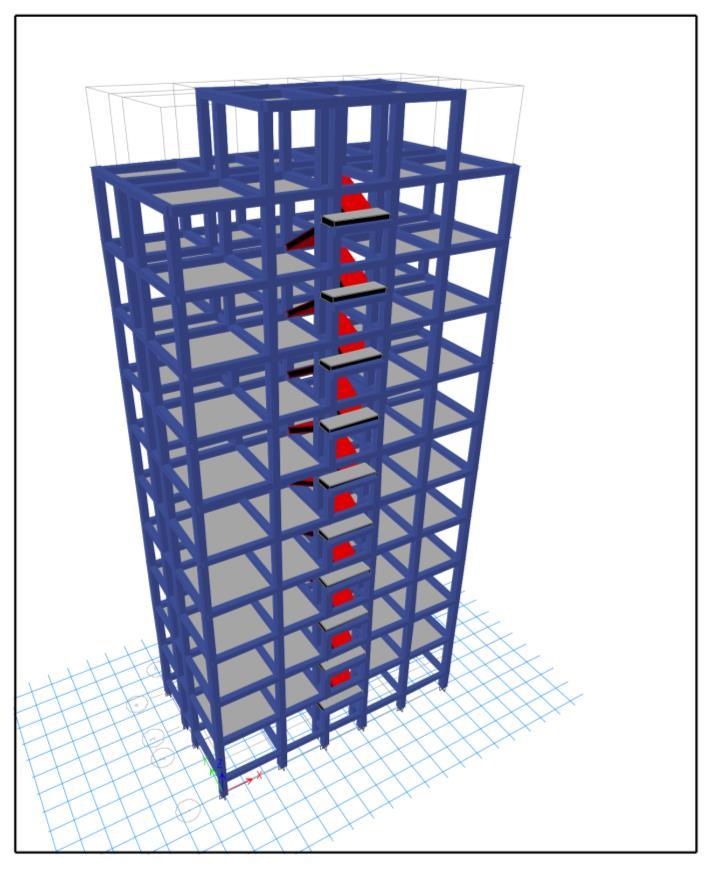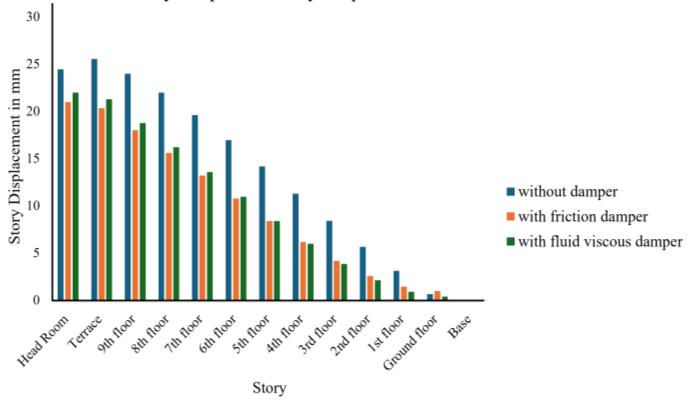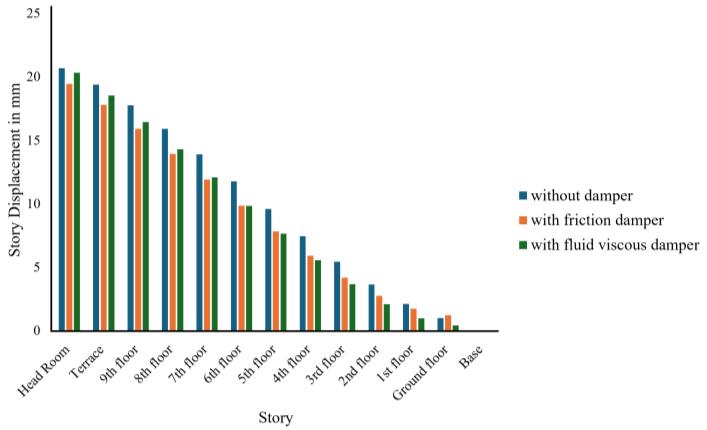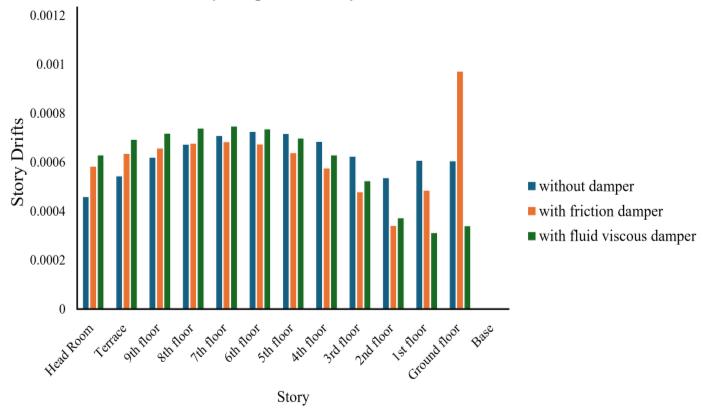
International Research Journal of Engineering and Technology (IRJET) e-ISSN: 2395-0056
Volume: 12 Issue: 02 | Feb 2025 www.irjet.net p-ISSN: 2395-0072


International Research Journal of Engineering and Technology (IRJET) e-ISSN: 2395-0056
Volume: 12 Issue: 02 | Feb 2025 www.irjet.net p-ISSN: 2395-0072
Chandan Sah 1
1 Department of Civil Engineering, Hindustan Institute of Technology and Science, Padur, Chennai, India ***
Abstract - This study investigates the seismic performance of an RCC framed G+9 building structure, focusing on the use of fluid viscous dampers and friction dampers to enhance resilienceandreducevibrationscausedbygroundmotion.The building's architectural and structural design was developed usingAutoCAD, withmanualdesigncalculationsandmodeling performed in ETABS software. Various load scenarios, including live, dead, wind, and seismic loads, were considered to evaluate the effectiveness of both damper types. Key findings reveal that both damping systems significantly improved the building’s performance compared to the undamped configuration. Friction dampers demonstrated superior results, particularly in stiffness enhancement, showing an average improvement of 48% and reducing maximum story displacements by 3% in the X-direction and 5% in the Y-direction. Fluid viscous dampers also performed well, especially in minimizing story drifts in the Y-direction, achieving a 0.5% improvement in both X and Y directions. A comparativeanalysis highlightsthatfrictiondampersexcelled in stiffness control, while fluid viscous dampers were more effective in vibration reduction. The study concludes that incorporating damping systems is crucial for improving the safetyandresilienceof RCC structures inseismic-proneareas, offering valuable insights for better decision-making in structural design and implementation.
Key Words: Structural analysis, fluid viscous damper, frictiondamper,Storydrift
Intheworldofstructuralengineering,theseismicanalysisof buildingsstandsasacornerstoneintheworldofstructural engineering, the seismic analysis of buildings stands as a cornerstoneinensuringtheirsafetyandresilienceagainst the formidable forces of earthquakes. As seismic events continue to pose significant threats to infrastructure worldwide, the integration of effective damping systems emerges as a paramount strategy in fortifying buildings against potential devastation. [1-3] Among the array of damping technologies, friction dampers and fluid viscous dampershaveemergedasnotablecontenders,eachoffering unique features and advantages in mitigating structural vibrationsandenhancingseismicperformance.[4-7]
Friction dampers harness the principle of friction to dissipateenergyandattenuatetheoscillationsinducedby seismic forces. By strategically introducing controlled
frictional resistance within the structural framework, friction dampers bolster the building's stiffness and resilience, thereby augmenting its ability to withstand seismicloads.[8,9]Ontheotherhand,fluidviscousdampers leverage the viscous properties of fluids to absorb and dissipate energy,offeringa versatile solution fordamping structuralvibrationsacrossawidespectrumoffrequencies. Theinherentcharacteristicsoffluidviscousdampersmake them adept at mitigating both low and high-amplitude vibrations, thereby providing comprehensive protection againstseismichazards.[10,11]
Central to the study's methodology is the utilization of ETABSsoftware,arobuststructuralanalysisanddesigntool renownedforitscapabilitytosimulatecomplexstructural behaviors under various loading conditions. Through meticulousarchitecturalandstructuraldesign,coupledwith rigorous manual calculations and modeling within the ETABS environment, the study aims to comprehensively evaluate the seismic performance of an RCC framed G+9 buildingstructure.[12]Bysubjectingthebuildingmodelto live,dead,wind,andseismicloads,thestudyendeavorsto elucidatetheefficacyoffrictiondampersandfluidviscous dampersinmitigatingstructuralvibrationsandenhancing overallseismicresilience.
Ultimately, the study underscores the paramount importance of damping systems in safeguarding buildings against seismic hazards. By harnessing the unique capabilitiesoffrictiondampersandfluidviscousdampers, engineerscaneffectivelyfortifystructures,therebyaverting potential damage and preserving lives and livelihoods. Throughmeticulousanalysisandthoughtfulintegrationof dampingtechnologies,thestudyendeavorstocontributeto theadvancementofresilientinfrastructure,pavingtheway for safer and more sustainable built environments in seismic-proneregions[13,14].
Thisstudyaimstoconductacomprehensiveanalysisofthe seismic performance of an RCC framed G+9 building structure,focusingonthe efficacyoffrictiondampersand fluidviscousdampersinenhancingresilienceagainstseismic hazards. Through the utilization of ETABS software, the objectives encompass developing a detailed architectural andstructuraldesigninadherencetoIndianbuildingcodes, performing thorough structural analysis under diverse loadingconditions,andevaluatingseismicperformanceby assessingfactorslikedisplacements,drifts,andaccelerations

International Research Journal of Engineering and Technology (IRJET) e-ISSN: 2395-0056
Volume: 12 Issue: 02 | Feb 2025 www.irjet.net p-ISSN: 2395-0072
(15, 16). Additionally, the effectiveness of dampers in reducing structural vibrations is assessed, with a specific focus on friction dampers and fluid viscous dampers. A comparativeanalysisisconductedtogaugetheadvantages anddisadvantagesofeachdampertype,consideringfactors such as cost-effectiveness and long-term maintenance requirements (17-20). By systematically addressing these objectives,thestudyaimstoprovidevaluableinsightsinto theroleofdampingtechnologiesinenhancingtheseismic resilienceofbuildingstructures,therebycontributingtothe advancement of resilient infrastructure in seismic-prone regions.
TheprocessusedinthisstudyreportstartswiththeAutoCAD drawingofaG+9Buildingdesign.Athoroughmanualdesign calculations is then performed for a variety of structural components,includingasslabs,beams,columns,andstairs. After that, the structure is modelled using the ETABS Software,considering various load circumstanceslike live, dead, wind, and seismic loads. After that, the building's structuralanalysisiscarriedout,accountingforeachofthese loadcircumstances,andtheoutcomesarecarefullyanalyzed.
Moreover, the study incorporates the characteristics of viscousandfrictiondampers.Thedampercharacteristicsare takenintoconsiderationduringtwoseparatephasesofthe building's seismic performance evaluation. The seismic analysisfindingsoftheviscousdampersandfrictiondampers arethencompared,andathoroughanalysisoftheresultsis carriedout.
The architectural and structural details are provided in Table1below.Thisinformationisessentialfortheanalysis. A thorough understanding of these details is vital for evaluating the building's performance, particularly under dynamic loading conditions. These architectural and structural details serve as a foundation for advanced modeling and simulation efforts. Figure 1 presents a 3D renderedviewofthestructure.
Table -1: Architectural
An Architectural Plan of Building confirming to all Architectural aspectsasrequired:
1 TypeofStructure : Multi-Storeys Rigid Jointed RC Frame Structure
2 No.ofStoreys : G+9Storeys
3 FloortoFloorHeight : 3meters
4 PlinthLevel : 1.25meteraboveGround Level
5 LocationofStructure : Chennai- Tamil NaduIndia SiteDetails
6 Surrounding Location of Structure : UrbanRegion:Developed ComplexArea
7 Type of Soil on which Structureisrest : Medium Soil (Poorly GradedSand:StiffSoil)
8 SafeBearingCapacityofSoil : 400kN/m2

Thepivotalinunderstandinghowthestructureisexpected torespondtoseismicevents.Table2tabulatedtheseismic detailsutilizedinthisstudy.Thesefactorsareessentialfor conducting accurate seismic analyses, as they help determinetheforcesthatthebuildingwillexperienceduring an earthquake. Moreover, the selection of appropriate seismic design criteria is crucial for ensuring that the structure meets safety standards and performance objectives.

International Research Journal of Engineering and Technology (IRJET) e-ISSN: 2395-0056
Volume: 12 Issue: 02 | Feb 2025 www.irjet.net p-ISSN: 2395-0072
-2: SeismicAnalysisDetailsofStructure
1 SeismicZone : III
2 ZoneFactor(Z) : 0.16
3 SiteType : IIforMediumSoilasperTable 4ofIS1893(Part1):2016
4 ImportanceFactor(I) : 1.2asperCl.7.2.3andTable8 ofIS1893(Part1):2016
5 System : Special Moment Resisting Frame
6 Response Reduction Factor(R) : 5asperCl.7.2.6andTable9of IS1893(Part1):2016
7 Percentage of Imposed LoadtobeConsideredin SeismicWeight : 25%forLLisupto3kN/m2 asperCl.7.3.1andTable10of IS1893(Part1):2016
5.1. Fluid viscous damper
Taylor Devices Inc.'s fluid viscous dampers are engineered for exceptional performance during dynamic eventslikeearthquakes.Thesedampersfeaturenon-linear characteristics with tight tolerances, ensuring long-term reliability.Thedampingforceisvelocity-dependent,peaking when structural stress is minimal and reducing to zero at maximumdeflection,effectivelydissipatingenergywithout requiring additional structural reinforcement. They also provideperfectre-centeringduetonear-zeroresistanceat lowvelocities.Inthisstudy,aTaylorDevicesfluidviscous damper(Model17120)withaforcecapacityof250kNanda weightof45kgwasequippedinthebuildingforanalysis.
5.2. Friction dampers
PallDynamicsLimited,atopauthorityondamping systems, provided the specifications that were used to evaluatethefrictiondamperinthisstudy.Thedamperthat wasselectedforanalysisweighs0.225kNandhasamassof 2000kg.ItslinearpropertiesweremodeledintheETABS programwithaneffectivedampingcapacityof4000kN-s/m and an effective stiffness of 20000 kN/m. By dispersing energythroughfriction,thesefeaturesallowthedamperto efficiently moderate vibrations. The damper, which is designed to function exceptionally well under dynamic loading circumstances, ensures dependable operation, longevity,andeffectivenessinmitigatingvibrationsresulting from wind or seismic forces. This damper's ability to improvestructuralstabilityandresiliencewashighlighted by its comprehensive performance features, which were essentialtotheanalysisconductedinthisstudy.
The analysis results, presented below through graphical representations,includeStoryResponseforStoryStiffness (X-Direction and Y-Direction), Story Displacement (XDirectionandY-Direction),andStoryDrifts(X-Directionand Y-Direction).
TheresultpresentedtheStoryResponse-StoryStiffnessin theX-directionforthreedifferentstructuralconfigurations: withoutanydamper,withafrictiondamper,andwithafluid viscousdampershowninfigure2.Thestiffnessvalueswere examinedatdifferentfloors,specificallyatthegroundfloor andtheheadroomlevel.
Themaximumandminimumstorystiffnessvalues forthestructurewithoutanydamperwereobservedtobe 592,286.868 kN/m for the ground floor and 22,950.647 kN/m for the headroom. When a friction damper was attached to the structure, the stiffness values significantly increased,withamaximumstiffnessof1,218,623.969kN/m forthegroundfloorand24,797.707kN/mfortheheadroom. Similarly, for the structure equipped with a fluid viscous damper, the stiffness values experienced an increase comparedtotheundampedstructure,withvaluesreaching 909,022.466 kN/m for the ground floor and 24,101.394 kN/mfortheheadroom.
A notable observation from the result was the consistentpatternofhigherstoryresponseinthestructure equipped with the friction damper across all floors. This indicatedthatthepresenceofthefrictiondamperenhanced the stiffness of the structure, leading to a more robust response to external forces. This effect was particularly prominent when compared to the structure without any damperandtheonewithafluidviscousdamper.
Inpracticalterms,theincreasedstiffnessprovided by the friction damper suggested improved structural performance in mitigating vibrations and dynamic loads, whichcouldhavepotentiallyenhancedtheoverallresilience and safety of the structure, especially in seismic-prone regionsorareaswithhighwindloads.
Overall, the result highlighted the significant influence of damping systems, particularly friction dampers, on the stiffness and response characteristics of the structure, underscoring their importance in structural engineering applications for mitigating dynamic effects and ensuring structuralintegrityundervariousloadingconditions.

International Research Journal of Engineering and Technology (IRJET) e-ISSN: 2395-0056
Volume: 12 Issue: 02 | Feb 2025 www.irjet.net p-ISSN: 2395-0072

The result depicts the Story Response - Story Stiffness in the Y-direction for three different structural configurations:withoutanydamper,withafrictiondamper, and with a fluid viscous damper shown in figure 3. The stiffnessvalueswereanalyzedatvariousfloors,specifically atthegroundfloorandtheheadroomlevel.
For the structure without any damper, the maximum and minimum story stiffness values were recorded as 659,370.618 kN/m for the ground floor and 17,650.729kN/mfortheheadroom,respectively.Uponthe introductionofafrictiondampertothestructure,therewas a noticeable increase in stiffness, with values reaching a maximumof1,070,574.832kN/mforthegroundfloorand 17,254.214kN/mfortheheadroom.Similarly,thestructure equipped witha fluid viscous damper exhibitedincreased stiffnesscomparedtotheundampedstructure,withvalues reaching816,291.5kN/mforthegroundfloorand16,698.91 kN/mfortheheadroom.
An evident trend observed in the result was the consistentlyhigherstoryresponseinthestructureequipped withthefrictiondamperacrossallfloors.Thisimpliedthat thepresenceofthefrictiondampercontributedtoenhanced stiffnessandresponsecharacteristicsofthestructureinthe Y-direction. This effect was consistent across all floors, indicating the effectiveness of the friction damper in improving the structural performance under dynamic loadingconditions.
Practically,theincreasedstiffnessprovidedbythe friction damper suggested improved structural resilience againstlateralforcessuchaswindorseismicloads,which were common challenges in structural engineering. The enhanced response could potentially mitigate the risk of structuraldamageandimproveoccupantsafetyinbuildings.
Insummary,theresultunderscoredthesignificant influenceofdampingsystems,particularlyfrictiondampers, onthestiffnessandresponsebehaviorofstructuresintheYdirection. The results highlighted the importance of
incorporatingdampingmechanismsintostructuraldesigns to optimize performance and ensure structural integrity undervaryingloadingconditions.

Chart -2:
6.3. Story response - story displacement (x-direction)
The result illustrates the Maximum Story DisplacementintheX-directionforthreedifferentstructural configurations:withoutanydamper,withafrictiondamper, and with a fluid viscous damper shown in figure 4. Displacement values were examined at each floor of the structure.
In structure without any damper, the maximum displacement was recorded at the terrace level, reaching 25.533mm,whiletheminimumdisplacementwasobserved atthegroundfloor,measuring0.639mm.Forthestructure with a friction damper, the maximum displacement decreased to 20.966 mm at the terrace level, with a minimum displacement of 0.971 mm at the ground floor. Similarly, in the structure equipped with a fluid viscous damper, the maximum displacement was significantly reducedto23.946mmattheterracelevel,andtheminimum displacementwas0.388mmatthegroundfloor.
A notable trend in the result was the consistent decreaseindisplacementvaluesfromthetoptothebottom floorsineachofthestructuralconfigurationsanalyzed.This decreasingorderofdisplacementimpliedthatthemaximum displacementoccurredatthetopmostfloorsofthestructure, while the minimum displacement was observed at the bottommostfloors.Thispatternwasexpectedinmulti-story structures,astheupperfloorsexperiencedgreaterdynamic forces and moments, resulting in larger displacements comparedtothelowerfloors.
The comparison between the three structural configurations revealed the effectiveness of damping systems in reducing maximum displacements. Both the frictiondamperandthefluidviscousdampercontributedto the mitigation of displacements across all floors, with the

International Research Journal of Engineering and Technology (IRJET) e-ISSN: 2395-0056
Volume: 12 Issue: 02 | Feb 2025 www.irjet.net p-ISSN: 2395-0072
structureequippedwiththefluidviscousdamperexhibiting themostsignificantreductioninmaximumdisplacement.
Practically, the reduction in maximum displacementsprovidedbydampingsystemsenhancedthe structuralperformanceandoccupantcomfort,particularlyin regions prone to seismic activity or high wind loads. By limitingexcessivedisplacements,dampingsystemshelped maintain structural integrity and minimized the risk of damageorcollapseduringdynamicevents.
Insummary,theresulthighlightedtheimportance of damping systems in controlling maximum story displacementsinmulti-storystructures,withacleartrendof decreasingdisplacementvaluesfromtopto bottom floors acrossdifferentstructuralconfigurations.Thisemphasized the role of damping systems in improving the overall performanceandsafetyofstructuresunderdynamicloading conditions.

6.4. STORY RESPONSE - STORY DISPLACEMENT (YDIRECTION)
The result presents the Maximum Story DisplacementintheY-directionforthreedifferentstructural configurations:withoutanydamper,withafrictiondamper, and with a fluid viscous damper shown in figure 5. Displacement values were evaluated at each floor of the structure.
Inthestructurewithoutanydamper,themaximum displacement was observed at the headroom level, measuring 20.675 mm, while the minimum displacement wasrecordedatthegroundfloor,withavalueof1mm.For the structure with a friction damper, the maximum displacement decreased to 19.453 mm at the headroom level, with a minimum displacement of 1.214 mm at the groundfloor.Similarly,inthestructureequippedwithafluid viscousdamper,themaximumdisplacementwasreducedto 20.319 mm at the headroom level, and the minimum displacementwas0.424mmatthegroundfloor.
Anoticeabletrendinthegraphwastheconsistent decreaseindisplacementvaluesfromthetoptothebottom floorsineachofthestructuralconfigurationsanalyzed.This decreasing order of displacement suggested that the maximumdisplacementoccurredattheuppermostfloorsof the structure, while the minimum displacement was observedatthelowermostfloors.Thispatternwastypicalin multi-story structures, where higher floors experienced greaterdynamicloadsandexhibitedlargerdisplacements comparedtolowerfloors.
Additionally, the comparison between the three structural configurations revealed that the structure equipped with the friction damper consistently exhibited lower displacement values at each floor compared to the otherconfigurations.Thisindicatedtheeffectivenessofthe frictiondamperinreducingmaximumstorydisplacements intheY-directionacrossallfloors.
Practically, the reduction in maximum displacementsprovidedbythefrictiondamperenhancedthe structuralperformanceandoccupantsafety,particularlyin regions prone to lateral forces such as wind or seismic activity. By limiting excessive displacements, the friction damperhelpedmaintainstructuralintegrityandreducedthe riskofdamageorcollapseduringdynamicevents.
Insummary,theresultemphasizedtheimportance of damping systems, particularly friction dampers, in controlling maximum story displacements in multi-story structures.Theconsistenttrendofdecreasingdisplacement values from top to bottom floors underscored the role of dampingsystemsinimprovingtheoverallperformanceand safetyofstructuresunderdynamicloadingconditions,with thefrictiondamperdemonstratingeffectivenessinreducing displacementsacrossallfloors.

6.5. STORY RESPONSE - STORY DRIFTS (X-DIRECTION)
The result presents Story Response - Maximum Story Drifts in the X-direction showcased drift values for three

International Research Journal of Engineering and Technology (IRJET) e-ISSN: 2395-0056
Volume: 12 Issue: 02 | Feb 2025 www.irjet.net p-ISSN: 2395-0072
distinctstructuralconfigurations:withoutanydamper,with africtiondamper,andwithafluidviscousdampershownin figure 6. Drift values were assessed on each floor of the structure. In the structure without any damper, the minimum drift value was observed at the headroom, measuring0.000334,whilethemaximumdriftwasnotedon the5thfloor,reaching0.000962.Withtheintroductionofa frictiondamper,theminimumdriftvalueslightlyincreased to 0.000373 at the 2nd floor, while the maximum drift decreasedto0.000810atthe7thfloor.Conversely,forthe structure equipped with a fluid viscous damper, the minimumdriftvaluedecreasedto0.000287attheground floor,withthemaximumdriftrecordedat0.000875onthe 7th floor. Although each structure exhibited varying drift values across different floors, upon comparison, the structurewiththefrictiondamperappearedtodemonstrate amorefavorableperformanceintermsofdriftreduction.

6.6. STORY RESPONSE - STORY DRIFTS (Y-DIRECTION)
TheresultillustratesStoryResponse-MaximumStory DriftsintheY-directionprovidedananalysisofdriftvalues for three distinct structural configurations: without any damper, with a friction damper, and with a fluid viscous damper shown in figure 7. Displacement values were assessed on each floor of the structure. In the structure withoutanydamper,theminimumdriftvaluewasobserved attheheadroom,measuring0.000458,whilethemaximum driftwasnotedonthe6thfloor,reaching0.000724.Withthe inclusion of a friction damper, the minimum drift value decreasedto0.000340atthe2ndfloor,whilethemaximum driftincreasedto0.000971atthegroundfloor.Similarly,for the structure equipped with a fluid viscous damper, the minimumdriftvaluedecreasedto0.000311atthe1stfloor, with the maximum drift recorded at 0.000746 on the 7th floor. The variation in drift values across different floors underscored the importance of analyzing and controlling drifttoensurestructuralstabilityandsafety.Whileboththe friction damper and fluid viscous damper configurations showedcomparableperformanceinreducingdriftcompared totheundampedstructure,furtherevaluationwasdeemed
necessarytodeterminethemostsuitabledampingsystem forspecificstructuralrequirements.

Intheconclusionthe buildinganalysisperformed usingETABSsoftwareforstudyingtheseismicperformance ofthestructurewithfrictiondamperandviscousdamper. Throughamethodicalassessmentofmanyfactors,including maximumstorystiffness,displacement,anddrifts,thestudy highlights the critical function of dampers in reducing structural vibrations and enhancing overall resistance to seismic risks. The following is a list of the significant and noteworthyfindings:
The comparative study analyzed the structural responseofanRCCframedG+9buildingstructure using fluid viscous dampers and friction dampers acrossvariousparameters.
Key findings revealed that both damping configurations effectively enhancedthestructural responsecomparedtotheundampedstructure.
Structures equipped with dampers consistently exhibited higher stiffness values, lower displacement values, and reduced drifts, emphasizingtheimportanceofdampingsystemsin enhancingperformanceandsafety.
Frictiondampersdemonstratedthehigheststiffness values across all floors, indicating superior resistancetoexternalforces.
Structures equipped with dampers consistently exhibited higher stiffness values, with friction dampersshowinganaverageimprovementof48% inbothXandYdirectionsforstorystiffness.
The friction damper configuration consistently reducedmaximumstorydriftsmoreeffectivelythan thefluidviscousdamperandundampedstructures,

International Research Journal of Engineering and Technology (IRJET) e-ISSN: 2395-0056
Volume: 12 Issue: 02 | Feb 2025 www.irjet.net p-ISSN: 2395-0072
while the fluid viscous damper performed well in the Y-direction, improvingstory driftsby 0.5% in bothXandYdirections.
The friction damper configuration consistently exhibitedlowermaximumstorydisplacementsand drifts compared to the fluid viscous damper and undampedstructures.
The fluid viscous damper configuration also performedwellinreducingmaximumstorydrifts, particularlyintheY-direction,showingcomparable resultstothefrictiondamperconfiguration.
In terms of story displacement, friction dampers exhibitedlowermaximumdisplacementvaluesthan the fluid viscous damper, with an average improvement of 3% in the X-direction and a marginal difference of 5% in the Y-direction.
Overall,thestudycontributesvaluableinsightsto thefieldofstructuralengineeringandaidsintheinformed selectionandimplementationofdampingtechnologiesfor enhancing the performance of RCC framed building structures.
[1] Raghu, V., & Dr. Ch. Bhavannarayana. (2022). A comparativestudyonanalysisofRCCframedstructure usingviscousdamper,tunedmassdamper,andfriction dampers.
[2] Nabida,N.,&Hajirasoulihaa,I.(2020).Optimumenergy based seismic design of friction dampers in RC structures. Structures, 12, 34-46. https://doi.org/10.1016/j.istruc.2020.08.052
[3] Hua, G., Wang, Y., & Huang, W. (2018). Seismic mitigation performance of structures with viscous dampers under near-fault pulse-type earthquakes. Engineering Structures, 10, 123-136. https://doi.org/10.1016/j.engstruct.2019.109878
[4] Amjadian,M.,&Agrawal,A.K.(2019).Seismicresponse control of multi-story base-isolated buildings using a smart electromagnetic friction damper with smooth hysteretic behavior. Mechanical Systems and Signal Processing, 12, 345-358. https://doi.org/10.1016/j.ymssp.2019.05.018
[5] De Domenicoa, D., & Ricciardi, G. (2019). Design strategiesofviscousdampersforseismicprotectionof building structures. Soil Dynamics and Earthquake Engineering, 10(2), 145-156. https://doi.org/10.1016/j.soildyn.2018.12.024
[6] Ding,J.,Wang,S.,&Wu,H.(2018).Seismicperformance analysisofviscousdampingoutriggerinsuperhigh-rise buildings. The Structural Design of Tall and Special Buildings, 27(13), e1486. https://doi.org/10.1002/tal.1486
[7] Bhardwaj,S.,Singh,P.,&Dixit,S.(2022).Lineardynamic analysisofhigh-riseirregularstructureswithorwithout LFRS&frictionaldamper.MaterialsToday:Proceedings, 69, 499-507. https://doi.org/10.1016/j.matpr.2022.09.256
[8] Nishanth,C.L.,Swaroop,Y.S.,Jagarapu,D.C.K.,&Jogi,P. K.(2020).Analysisanddesignofcommercialbuilding withdifferentslabarrangementsusingETABS.Materials Today: Proceedings, 33, 700-704. https://doi.org/10.1016/j.matpr.2020.05.823
[9] Divya,R.,&Murali,K.(2022).Comparativeanalysisof behaviorofhorizontalandverticalirregularbuildings withandwithoutusingshearwallsbyETABSsoftware. Materials Today: Proceedings, 52, 1821-1830. https://doi.org/10.1016/j.matpr.2021.11.489
[10] Fan, H., Li, Q. S., Tuan, A. Y., & Xu, L. (2009). Seismic analysis of the world’s tallest building. Journal of Constructional Steel Research, 65(5), 1206-1215. https://doi.org/10.1016/j.jcsr.2008.10.005
[11] Cruz, C., & Miranda, E. (2017). Evaluation of damping ratiosfortheseismicanalysisoftallbuildings.Journalof Structural Engineering, 143(1), 04016144. https://doi.org/10.1061/(ASCE)ST.1943-541X.0001628
[12] Hart,G.C.,Brandow,G.E.,Brugger,L.,Carpenter,L.D., Quadri, N. D., Huang, S. C., ... & Lew, M. (2012). An alternative procedure for seismic evaluation and strengtheningoftallbuildings.TheStructuralDesignof Tall and Special Buildings, 21, 3-11. https://doi.org/10.1002/tal.1063
[13] Paret,T.F.,Freeman,S.A.,Searer,G.R.,Hachem,M.,& Gilmartin,U.M.(2008).Usingtraditionalandinnovative approachesintheseismicevaluationandstrengthening of a historic unreinforced masonry synagogue. Engineering Structures, 30(8), 2114-2126. https://doi.org/10.1016/j.engstruct.2007.03.023
[14] Shaik Akhil Ahamad, & Pratap, K. V. (2020). Dynamic analysisofG+20multistoriedbuildingbyusingshear wallsinvariouslocationsfordifferentseismiczonesby usingETABS.MaterialsToday:Proceedings,25,18521859.https://doi.org/10.1016/j.matpr.2020.08.014
[15] Buckley,R.T.,&Smith,B.A.(2020).Advancedvibration control systems for high-rise buildings using friction dampers. Journal of Structural Engineering, 146(2),

International Research Journal of Engineering and Technology (IRJET) e-ISSN: 2395-0056
Volume: 12 Issue: 02 | Feb 2025 www.irjet.net p-ISSN: 2395-0072
04019190. https://doi.org/10.1061/(ASCE)ST.1943541X.0002512
[16] Jayalekshmi,B.R.,&Sengupta,P.(2019).Performance evaluation of friction dampers in reducing seismic response of irregular structures. Earthquake Engineering&StructuralDynamics,48(14),1447-1460. https://doi.org/10.1002/eqe.3184
[17] Patil,S.S.,&Kulkarni,K.P.(2021).Acomparativestudy on the seismic performance of RCC structures using viscous and friction dampers. International Journal of CivilEngineeringandTechnology,12(6),242-250.
[18] Therani, S. K., & Prasad, K. V. (2022). Effectiveness of frictiondampersinenhancingtheseismicperformance ofirregularhigh-risebuildings.StructuralEngineering and Mechanics, 84(1), 111-124. https://doi.org/10.12989/sem.2022.84.1.111
[19] Chen,H.,Gao,Q.,&Xie,Q.(2017).Seismicperformance analysis of tall buildings with distributed dampers underirregularmassconditions.JournalofEarthquake Engineering, 21(4), 511-526. https://doi.org/10.1080/13632469.2016.1206401
[20] Mandapaka,R.,&PradeepKumar,P.(2023).Analysisof friction dampers for vibration control in multi-storey structures subjected to seismic forces. Journal of PerformanceofConstructedFacilities,37(3),04023018. https://doi.org/10.1061/(ASCE)CF.1943-5509.0001823
© 2025, IRJET | Impact Factor value: 8.315 | ISO